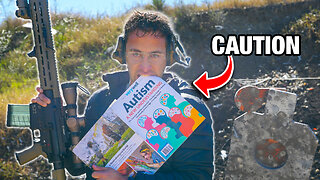Premium Only Content

Portable Loading Ramps Training
**Portable Loading Ramps Training** is essential for ensuring safety during the loading and unloading of goods. This training minimizes risks associated with equipment instability, improper use, and accidents. Below is a comprehensive guide for developing and conducting training sessions on portable loading ramps.
---
### **1. Objectives of the Training**
- Teach employees how to safely set up, use, and store portable loading ramps.
- Highlight hazards and precautions to prevent injuries and damage.
- Promote safe practices for loading and unloading tasks involving ramps.
---
### **2. Key Hazards Associated with Portable Loading Ramps**
- **Ramp Instability**: Caused by improper setup or uneven surfaces.
- **Slipping and Falling**: Due to wet, oily, or debris-covered ramp surfaces.
- **Overloading**: Exceeding the ramp’s weight capacity can cause structural failure.
- **Vehicle Movement**: Sudden movement during loading/unloading can displace the ramp.
- **Pinch Points**: During ramp setup or folding.
- **Improper Inclination**: Too steep or shallow angles can lead to accidents.
---
### **3. Personal Protective Equipment (PPE)**
- **Mandatory PPE**:
- Safety boots with slip-resistant soles.
- Gloves for handling ramps (to avoid cuts or pinching).
- **Optional PPE**:
- Hard hats if working under raised cargo or near overhead hazards.
- High-visibility vests in busy loading zones.
---
### **4. Pre-Use Inspections**
- **Ramp Condition**:
- Check for cracks, bends, or other structural damage.
- Ensure hinges and locks are secure and functional.
- **Surface**:
- Verify that the ramp surface is free from debris, water, or oil.
- Inspect anti-slip coatings or treads for wear and tear.
- **Weight Capacity**:
- Confirm the ramp can handle the combined weight of the cargo, equipment, and operator.
- **Environment**:
- Ensure the ground is stable, level, and free of obstructions where the ramp will be placed.
---
### **5. Setup and Positioning**
- **Proper Placement**:
- Align the ramp securely to the loading dock, vehicle, or container.
- Use safety chains, locking mechanisms, or clamps to prevent movement.
- Verify that the angle is appropriate and does not exceed the manufacturer’s recommendations.
- **Stability Checks**:
- Place ramp feet or supports on solid, non-slippery surfaces.
- Avoid placing ramps on gravel, uneven terrain, or slopes without stabilization.
---
### **6. Safe Usage Practices**
- **Loading and Unloading**:
- Always move cargo in a controlled and steady manner.
- Walk or drive (if using equipment) straight up or down the ramp; avoid sharp turns.
- Maintain a safe speed when operating machinery like forklifts or pallet jacks on the ramp.
- **Personnel Movement**:
- Do not stand on or near the ramp while machinery or cargo is in transit.
- Avoid walking backward when carrying loads up or down the ramp.
- **Weight Management**:
- Never exceed the ramp’s maximum weight capacity.
- Distribute weight evenly across the ramp.
---
### **7. Post-Use Procedures**
- **Cleaning**:
- Remove debris, grease, or dirt from the ramp surface.
- **Inspection**:
- Recheck for any new damage after use.
- **Storage**:
- Fold the ramp (if applicable) and store it in a designated area away from vehicle traffic or harsh weather conditions.
---
### **8. Emergency Procedures**
- **In Case of Ramp Collapse**:
- Evacuate the area and prevent further use until repairs are made.
- Report the incident to the supervisor immediately.
- **For Slips or Falls**:
- Administer first aid and report the incident.
- Investigate the cause (e.g., slippery surfaces) and take corrective action.
---
### **9. Training Delivery Methods**
- **Classroom Training**:
- Use slides or videos to explain ramp components, setup procedures, and common hazards.
- **Hands-On Training**:
- Practice proper setup, use, and storage of the ramp.
- Simulate real-world loading/unloading scenarios.
- **Toolbox Talks**:
- Conduct short, on-site discussions before tasks involving ramps.
---
### **10. Follow-Up and Refresher Training**
- Periodically review ramp safety practices, especially after incidents or equipment upgrades.
- Update training to include new equipment types or manufacturer recommendations.
- Conduct spot checks to ensure compliance with safety protocols.
---
Would you like assistance in creating visual aids, checklists, or a full training presentation?
-
 1:35
1:35
HSESafetyInformation
8 months agoMutton Chops two ways- baked & grilled Recipe by Food Fusion (Eid Recipe)
73 -
 38:16
38:16
daniellesmithab
3 days agoAlberta Update: Getting Kids Back to the Classroom
28.4K11 -
 20:48
20:48
BlaireWhite
5 days agoTrans TikTokers Are Crashing Out (Over Nothing)
32.6K11 -
 2:07:06
2:07:06
Side Scrollers Podcast
22 hours agoHasan Piker CAUGHT LYING AGAIN + Twitch URGES LEFTIST IDEOLOGY + More | Side Scrollers
74.8K11 -
 8:40
8:40
MattMorseTV
18 hours ago $14.34 earnedSchumer just KICKED OFF the Left-Wing CIVIL WAR.
35.8K34 -
 21:39
21:39
Nikko Ortiz
2 days agoI Take A North Korean Shooting
33.5K6 -
 1:46:26
1:46:26
The Michelle Moore Show
21 hours ago'The Religion Invasion In the U.S. and the Deep State Agenda' Guest, Mark Taylor: The Michelle Moore Show (Nov 3, 2025)
41.9K42 -
 LIVE
LIVE
TruthStream with Joe and Scott
5 days agoSovereign Codes & Cosmic Infrastructure,Ufo's, UAP's, Monads, Matrix Satellites, Interstellar Visitors, SYRONA #505
302 watching -
 LIVE
LIVE
Lofi Girl
2 years agoSynthwave Radio 🌌 - beats to chill/game to
149 watching -
 5:55:11
5:55:11
MattMorseTV
14 hours ago $103.92 earned🔴Trump's '60 Minutes' INTERVIEW + MUCH MORE.🔴
165K53